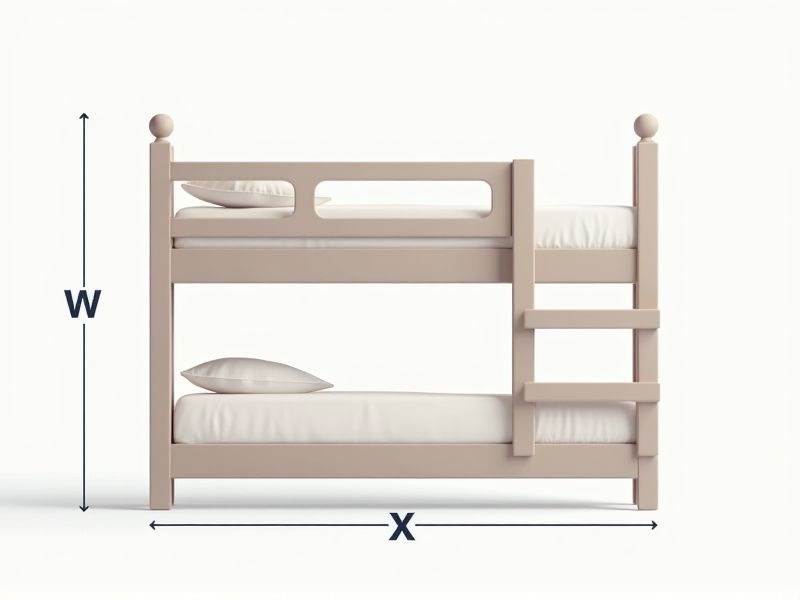
When selecting a bunk bed, knowing the standard dimensions is essential for ensuring it fits comfortably in your space. Most twin-over-twin bunk beds measure about 39 inches wide, 75 inches long, and 65 to 72 inches high, making them suitable for children's rooms or smaller spaces. Full-over-full bunk beds are typically larger, at around 54 inches wide by 75 inches long, and offer more sleeping space for older children or adults. Always consider ceiling height and the recommended clearance above the top bunk (at least 33 to 36 inches) for safety and comfort.
Overall Height
The overall height of a standard bunk bed typically ranges between 5 to 6.5 feet, allowing for ample headroom in most bedrooms. Most designs accommodate standard twin mattresses, which are 38 inches by 75 inches, ensuring a comfortable sleeping experience. It's essential to consider the height of your ceiling, which should ideally be at least 8 feet to provide safe clearance above the top bunk. When selecting a bunk bed, ensure that the height also factors in your personal preferences and the space constraints of your room.
Twin Size Dimensions
A standard twin-size bunk bed typically measures 39 inches in width and 75 inches in length, offering efficient space utilization in smaller rooms. The upper bunk is usually positioned at a height of around 58 to 60 inches from the floor, providing ample headroom while maintaining safety. Most models are designed with weight capacities ranging from 250 to 400 pounds, ensuring durability for multiple users. Consider incorporating sturdy guardrails and a secure ladder for enhanced safety and accessibility in your twin bunk bed setup.
Full Size Dimensions
Full-size bunk beds typically measure 54 inches wide and 75 inches long, offering ample sleeping space for adults and children alike. The standard height of these beds ranges from 58 to 66 inches, allowing room for comfortable access to the upper bunk. Built from sturdy materials, such as solid wood or metal, they often support weight capacities of up to 400 pounds per sleeping area. When selecting a full-size bunk bed, consider safety features like guardrails and stabilization to ensure a secure sleeping environment.
Twin-Over-Full Dimensions
The standard dimensions for a twin-over-full bunk bed typically measure 79 inches in length and 57 inches in width, accommodating a twin mattress measuring 38 inches by 75 inches on the top bunk and a full mattress measuring 54 inches by 75 inches on the bottom. This configuration provides an efficient use of space, making it ideal for smaller bedrooms or shared living areas. The recommended weight capacity often ranges from 200 to 400 pounds, depending on the materials and construction quality, ensuring safety and durability. When selecting a bunk bed, consider the height clearance, as most designs require at least 3 feet of space between the top bunk and the ceiling for comfort and safety.
Mattress Thickness
The standard thickness for mattresses used on bunk beds typically ranges from 5 to 7 inches, ensuring a safe fit within the guardrails. This thickness allows for adequate cushioning while maintaining stability and safety, preventing the risk of falling. Many manufacturers recommend using mattresses that meet specific safety certifications, such as CertiPUR-US, which ensures low emissions and durability. When choosing a mattress for your bunk bed, ensure it complies with these standards to enhance both comfort and safety for the sleeper.
Guardrail Height
The guardrail height for bunk beds is a crucial safety standard, typically requiring a minimum height of 5 inches above the mattress. This ensures that users, particularly children, are prevented from rolling off the edge during sleep. According to safety regulations, the space between the top of the guardrail and the mattress should not exceed 3 inches to provide effective protection. When selecting a bunk bed, always verify that it meets these height specifications to ensure the safety and well-being of its occupants.
Ladder Spacing
Ladder spacing on bunk beds should ideally measure between 12 to 15 inches apart for safe and comfortable access. This specific range ensures that users can easily climb and descend without the risk of slipping or losing balance. When choosing a bunk bed, verify that the ladder rungs are at least 3 to 4 inches wide, providing adequate grip and stability. Ensuring proper ladder spacing not only enhances safety but also contributes to the overall usability and enjoyment of your bunk bed setup.
Headroom Clearance
When selecting a bunk bed, the recommended headroom clearance ranges from 30 to 36 inches between the top mattress and the ceiling to ensure comfort and safety. Adequate headroom allows for easy movement and reduces the risk of injury when occupants sit up in bed. For adults, consider a minimum clearance of 36 inches, while children can manage with 30 inches. Always measure your ceiling height before purchasing to ensure the right fit for your space.
Weight Capacity
When selecting a bunk bed, weight capacity is a critical factor to consider; most standard bunk beds support between 200 to 400 pounds per sleeping surface. This means that if you have a twin-over-twin configuration, the combined weight limit generally ranges from 400 to 800 pounds, accommodating children and adults. Manufacturers often recommend that you verify the bed's specifications to ensure safety and durability, particularly for dynamic uses like climbing or jumping. By prioritizing the appropriate weight capacity, you can ensure that your bunk bed provides a safe sleeping environment for users of varying sizes.
Frame Material Thickness
The standard for bunk bed frame material thickness typically ranges from 0.8 inches to 1.2 inches, ensuring durability and safety for users. A thicker frame helps support higher weight capacities, often accommodating up to 400 pounds for the upper bunk. In addition, selecting materials like solid wood or metal enhances overall structural integrity, reducing the risk of instability. It's essential to verify that the bed meets ASTM or CPSC safety standards, guaranteeing a secure sleeping environment for you or your loved ones.
